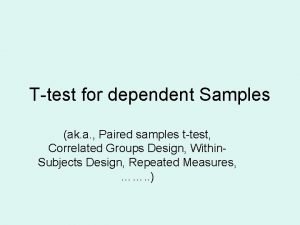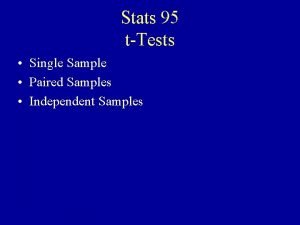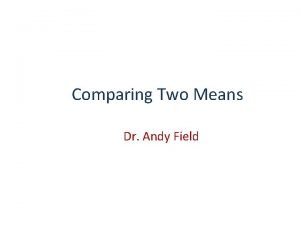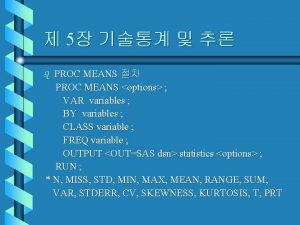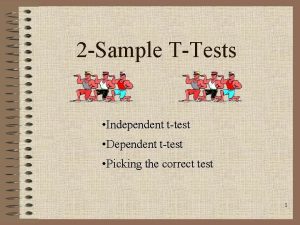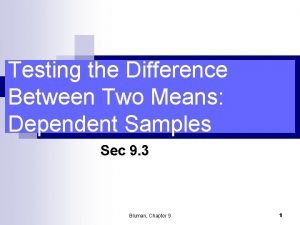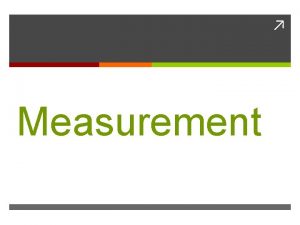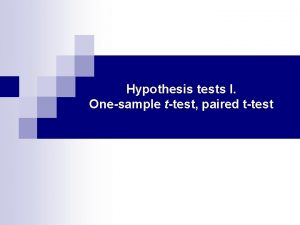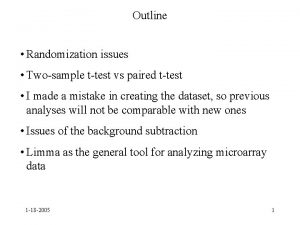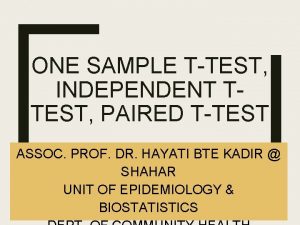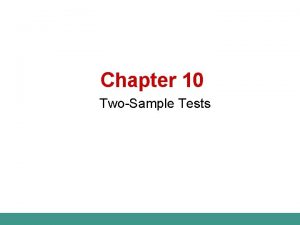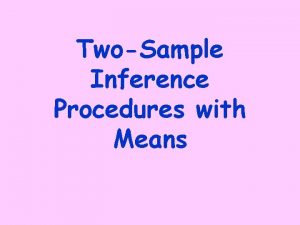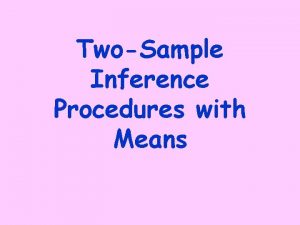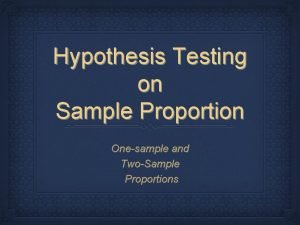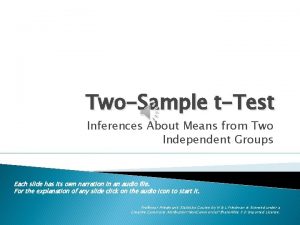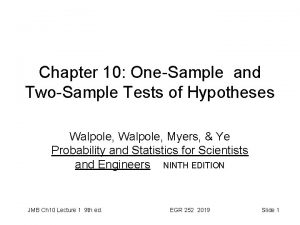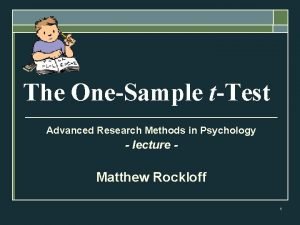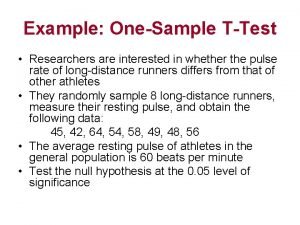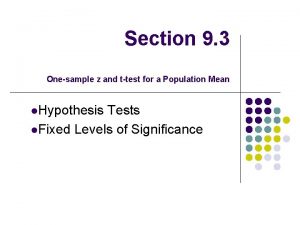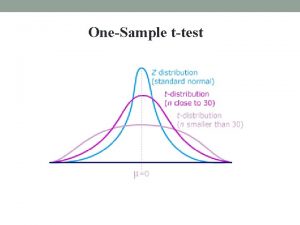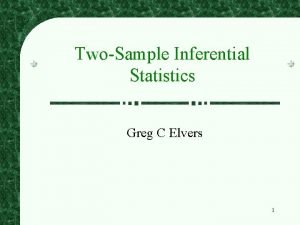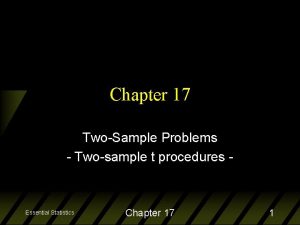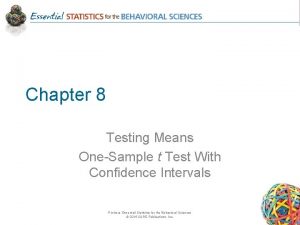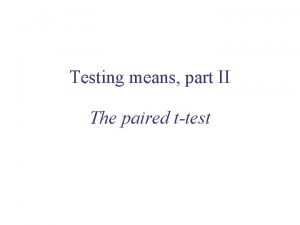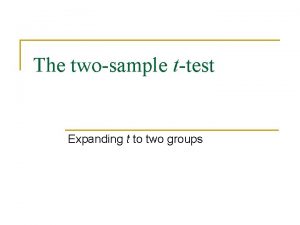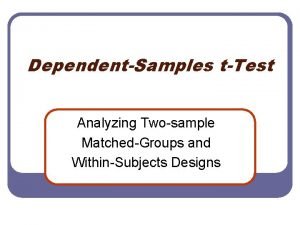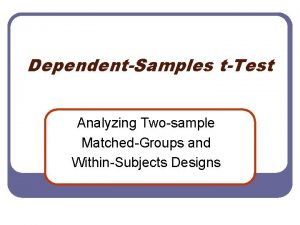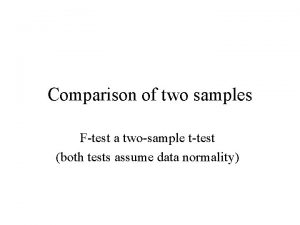Testing means part III The twosample ttest Onesample













































- Slides: 45

Testing means, part III The two-sample t-test

One-sample t-test Null hypothesis The population mean is equal to o Sample Test statistic compare Null distribution t with n-1 df How unusual is this test statistic? P < 0. 05 Reject Ho P > 0. 05 Fail to reject Ho

Paired t-test Null hypothesis The mean difference is equal to o Sample Test statistic compare Null distribution t with n-1 df *n is the number of pairs How unusual is this test statistic? P < 0. 05 Reject Ho P > 0. 05 Fail to reject Ho

Comparing means • Tests with one categorical and one numerical variable • Goal: to compare the mean of a numerical variable for different groups. 4

Paired vs. 2 sample comparisons 5

2 Sample Design • Each of the two samples is a random sample from its population 6

2 Sample Design • Each of the two samples is a random sample from its population • The data cannot be paired 7

2 Sample Design - assumptions • Each of the two samples is a random sample • In each population, the numerical variable being studied is normally distributed • The standard deviation of the numerical variable in the first population is equal to the standard deviation in the second population 8

Estimation: Difference between two means Normal distribution Standard deviation s 1=s 2=s Since both Y 1 and Y 2 are normally distributed, their difference will also follow a normal distribution 9

Estimation: Difference between two means Confidence interval: 10

Standard error of difference in means = pooled sample variance = size of sample 1 = size of sample 2 11

Standard error of difference in means Pooled variance: 12

Standard error of difference in means Pooled variance: df 1 = degrees of freedom for sample 1 = n 1 -1 df 2 = degrees of freedom for sample 2 = n 2 -1 s 12 = sample variance of sample 1 s 22 = sample variance of sample 2 13

Estimation: Difference between two means Confidence interval: 14

Estimation: Difference between two means Confidence interval: df = df 1 + df 2 = n 1+n 2 -2 15

Costs of resistance to disease 2 genotypes of lettuce: Susceptible and Resistant Do these differ in fitness in the absence of disease? 16

Data, summarized Both distributions are approximately normal. 17

Calculating the standard error df 1 =15 -1=14; df 2 = 16 -1=15 18

Calculating the standard error df 1 =15 -1=14; df 2 = 16 -1=15 19

Calculating the standard error df 1 =15 -1=14; df 2 = 16 -1=15 20

Finding t df = df 1 + df 2= n 1+n 2 -2 = 15+16 -2 =29 21

Finding t df = df 1 + df 2= n 1+n 2 -2 = 15+16 -2 =29 22

The 95% confidence interval of the difference in the means 23

Testing hypotheses about the difference in two means 2 -sample t-test 24

2 -sample t-test Test statistic: 25

Hypotheses 26

Null distribution df = df 1 + df 2 = n 1+n 2 -2 27

Calculating t 28

Drawing conclusions. . . Critical value: t 0. 05(2), 29=2. 05 t <2. 05, so we cannot reject the null hypothesis. These data are not sufficient to say that there is a cost of resistance. 29

Assumptions of two-sample t tests • Both samples are random samples. • Both populations have normal distributions • The variance of both populations is equal. 30

Two-sample t-test Null hypothesis The two populations have the same mean Sample 1 2 Test statistic compare Null distribution t with n 1+n 2 -2 df How unusual is this test statistic? P < 0. 05 Reject Ho P > 0. 05 Fail to reject Ho

Quick reference summary: Two-sample t-test • What is it for? Tests whether two groups have the same mean • What does it assume? Both samples are random samples. The numerical variable is normally distributed within both populations. The variance of the distribution is the same in the two populations • Test statistic: t • Distribution under Ho: t-distribution with n 1+n 2 -2 degrees of freedom. • Formulae:

Comparing means when variances are not equal Welch’s t test 33

Burrowing owls and dung traps 34

Dung beetles 35

Experimental design • 20 randomly chosen burrowing owl nests • Randomly divided into two groups of 10 nests • One group was given extra dung; the other not • Measured the number of dung beetles on the owls’ diets 36

Number of beetles caught • Dung added: • No dung added: 37

Hypotheses H 0: Owls catch the same number of dung beetles with or without extra dung ( 1 = 2) HA: Owls do not catch the same number of dung beetles with or without extra dung ( 1 2) 38

Welch’s t Round down df to nearest integer 39

Owls and dung beetles 40

Degrees of freedom Which we round down to df= 10 41

Reaching a conclusion t 0. 05(2), 10= 2. 23 t=4. 01 > 2. 23 So we can reject the null hypothesis with P<0. 05. Extra dung near burrowing owl nests increases the number of dung beetles eaten. 42

Quick reference summary: Welch’s approximate t-test • What is it for? Testing the difference between means of two groups when the standard deviations are unequal • What does it assume? Both samples are random samples. The numerical variable is normally distributed within both populations • Test statistic: t • Distribution under Ho: t-distribution with adjusted degrees of freedom • Formulae:

The wrong way to make a comparison of two groups “Group 1 is significantly different from a constant, but Group 2 is not. Therefore Group 1 and Group 2 are different from each other. ” 44

A more extreme case. . . 45
 Independent t test example
Independent t test example Paired samples t-test formula
Paired samples t-test formula Between subjects design vs within
Between subjects design vs within Graphpad ttest
Graphpad ttest T-test beispielrechnung
T-test beispielrechnung Proc ttest
Proc ttest Ttest ind
Ttest ind Hamlet act iii scene iii
Hamlet act iii scene iii Va handbook 5017 part iii appendix a
Va handbook 5017 part iii appendix a Domain testing example
Domain testing example Kv charts in software testing
Kv charts in software testing Data flow testing strategies in software testing
Data flow testing strategies in software testing Positive negative testing
Positive negative testing Cs 3250
Cs 3250 Globalization testing
Globalization testing Neighborhood integration testing
Neighborhood integration testing Cause effect graph for triangle problem
Cause effect graph for triangle problem Control structure testing in software engineering
Control structure testing in software engineering Decision table testing in software testing
Decision table testing in software testing Decision table based testing
Decision table based testing Blackbox testing adalah
Blackbox testing adalah Black-box testing disebut juga sebagai behavioral testing
Black-box testing disebut juga sebagai behavioral testing Decision table testing
Decision table testing Rigorous testing in software testing
Rigorous testing in software testing Testing blindness in software testing
Testing blindness in software testing Component testing is a black box testing
Component testing is a black box testing Domain testing in software testing
Domain testing in software testing Testing the difference between two means dependent samples
Testing the difference between two means dependent samples Quadrilateral pentagon hexagon octagon
Quadrilateral pentagon hexagon octagon Morphe means in metamorphism
Morphe means in metamorphism Meta means change and morph means heat
Meta means change and morph means heat Biodiversity conservation definition
Biodiversity conservation definition Life bio
Life bio Ali root word
Ali root word Hát kết hợp bộ gõ cơ thể
Hát kết hợp bộ gõ cơ thể Frameset trong html5
Frameset trong html5 Bổ thể
Bổ thể Tỉ lệ cơ thể trẻ em
Tỉ lệ cơ thể trẻ em Voi kéo gỗ như thế nào
Voi kéo gỗ như thế nào Tư thế worm breton
Tư thế worm breton Chúa yêu trần thế
Chúa yêu trần thế Môn thể thao bắt đầu bằng chữ đua
Môn thể thao bắt đầu bằng chữ đua Thế nào là hệ số cao nhất
Thế nào là hệ số cao nhất Các châu lục và đại dương trên thế giới
Các châu lục và đại dương trên thế giới Công của trọng lực
Công của trọng lực Trời xanh đây là của chúng ta thể thơ
Trời xanh đây là của chúng ta thể thơ
